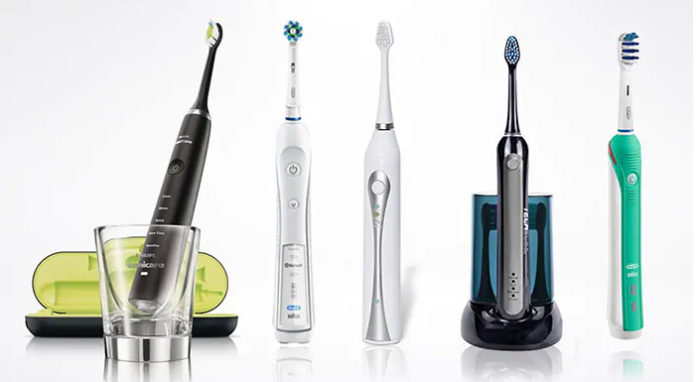.
What is an electric toothbrush?
The electric toothbrush generates high-frequency vibration through the rapid rotation or vibration of the motor core, and instantly decomposes the toothpaste into fine foam to deeply clean the teeth. At the same time, the vibration of the bristles can promote the blood circulation of the oral cavity, and has the massage effect to gingival tissue.
In short, the electric toothbrush is a kind of toothbrush that can clean your teeth via the auto-generated fast brush vibration.
 The first electric toothbrush was produced by the Electro Massage Tooth Brush Company in the U.S.A. in 1927. In Switzerland in 1954 Dr. Philippe Guy Woog invented the Broxodent.Woog’s electric toothbrushes were originally manufactured in Switzerland (later in France) for Broxo S.A. The device plugged into a standard wall outlet and ran on line voltage. Electric toothbrushes were initially created for patients with limited motor skills and for orthodontic patients (such as those with braces)
The first electric toothbrush was produced by the Electro Massage Tooth Brush Company in the U.S.A. in 1927. In Switzerland in 1954 Dr. Philippe Guy Woog invented the Broxodent.Woog’s electric toothbrushes were originally manufactured in Switzerland (later in France) for Broxo S.A. The device plugged into a standard wall outlet and ran on line voltage. Electric toothbrushes were initially created for patients with limited motor skills and for orthodontic patients (such as those with braces)
A toothbrush does the necessary job of vanquishing incredibly rude bacteria relentlessly working to mess up your oral health. “There’s a biofilm of bacteria that builds up in our mouths and our teeth and even in our gums. If it’s not removed, this biofilm becomes what we know as plaque,” dentist Maria Lopez Howell, D.D.S., an American Dental Association spokesperson, tells SELF. Plaque, which honestly has no chill, is “just forming all the time,” she adds. When not swept away frequently enough, plaque can lead to tooth decay and gingivitis (the first stage of gum disease, aka periodontitis), along with full-blown periodontitis. Without proper treatment, tooth decay and periodontitis can lead to tooth loss.
Why you should choose an electric toothbrush
Electric toothbrush has many advantages including convenient use and high cleaning efficiency. One thing for sure is that whether you can brush your teeth clean is less related to what brush you use, but the way you brush your teeth. Here the advantage of electric toothbrush is highlighted, as it is more suitable for people who do not master the scientific brushing skills. Besides, for those with oral and dental problems, electric toothbrushes are more suitable than manual ones.

How to choose electric toothbrush?
See how it works
The electric toothbrush can be classified according to the vibration mode of the toothbrush and the vibration frequency of the brush head. You should determine the different types of advantages and disadvantages before purchasing, and then combine with your own habits to determine which type you like.

See the cleaning effect
A big reason for choosing an electric toothbrush is to be optimistic about its cleaning effect. Generally speaking, the higher the vibration frequency, the better the cleaning effect, but you can’t blindly pursue the cleaning effect, or it should be combined with the condition of the teeth.

Look at the brush head
● The size of the brush head is appropriate: different people’s oral structure and the degree of adaptation to the brush head are different, according to their usual habits to choose the brush head.

● The cost of using the brush head:
The brush head is definitely the weight of the electric toothbrush. It is basically replaced once every 3 months. It is necessary to consider this part of the budget in advance.
Research will typically tell you electric toothbrushes have a slight edge, but it’s honestly not that huge.
For example, a 2014 review published in the Cochrane Library examined 51 randomized controlled trials involving adults and/or children brushing their teeth with electric or manual toothbrushes for at least four weeks. Overall, electric toothbrushes seemed to have an edge; when compared with manual toothbrushes, “there was an 11 percent reduction in plaque at one to three months of use, and a 21 percent reduction in plaque when assessed after three months of use,” the review’s authors concluded. “For gingivitis, there was a 6 percent reduction at one to three months of use and an 11 percent reduction when assessed after three months of use.”
However, the review’s authors also noted that “the evidence relating to plaque and gingivitis was considered to be of moderate quality.” And though these numbers may make it seem like you should go buy an electric toothbrush ASAP, experts say that this type of percentage difference doesn’t mean as much as you might think in practice.
“Most of these studies do show an electric brush of one sort or another removes a bit more bacteria than manual brush,” periodontist Steven Daniel, D.D.S., tells SELF. “But the differences tend to be pretty minimal. Not that they aren’t significant, but there’s not a huge black-and-white difference between being able to maintain good oral health using a manual toothbrush and an electric one.” Overall, the best toothbrush is whichever one you put in your hand twice a day to scrub away all that accumulated grossness.
With that said, an electric toothbrush makes more sense for some people than a manual version.
“One isn’t better than the other,” Dr. Howell says. “But sometimes the individual person will use one more easily than the other.” There are many varieties of electric toothbrushes out there. But instead of relying solely on a person to scrub plaque away, electric toothbrushes generally use vibration, rotation (going around in a circle), or oscillation (moving back and forth) to get the job done. They also tend to have larger handles than manual toothbrushes. These aspects make electric toothbrushes good options for people with dexterity issues due to conditions like rheumatoid arthritis and osteoporosis, or just aging in general.
Since the bristles on electric toothbrushes can sometimes be in thinner and pointier clusters, they can deliver the kind of targeted cleaning that can aid someone with braces or dental restorations, Dr. Daniel says. It may even just be that the vibrations intrigue an easily distracted kid, helping them spend the recommended two minutes brushing their teeth. And speaking of those two minutes, some electric toothbrushes actually have timers, which can be a great way to make sure you’re clocking all the QT your teeth and gums need.
Electric toothbrushes can also help if you brush your teeth and gums too hard, which can lead to gum recession that causes sensitivity while eating and drinking. Since electric toothbrushes do a lot of the work to remove plaque, putting too much pressure on your gums becomes less of an issue, Dr. Daniel says. Some even have pressure sensors that freeze the toothbrush’s motion if you’re pressing too hard.
No matter what kind of toothbrush you use, you should shop with a few guidelines in mind.
First, the American Dental Association recommends choosing toothbrushes with soft bristles, whether manual or electric. Anything harder can damage your gums and even form little notches in your teeth, Dr. Howell says. If you’re not sure where to start, you can look for toothbrushes with the American Dental Association Seal of Acceptance, meaning they live up to the organization’s standards for safety and effectiveness. Here are the manual versions, and here are the electric ones.
During your twice-daily, two-minute brushings, the ADA suggests holding your toothbrush at a 45-degree angle against your teeth and gum line, moving back and forth in short strokes, then tilting vertically and making up and down strokes on the insides of your teeth, too. (If you’re using an electric toothbrush, be sure to follow the manufacturer’s instructions.)
Beyond that, buy a new toothbrush every three to four months (or swap out the head of your electric toothbrush as instructed). “If those bristles are frayed, they’re not going to be able to get into the little crevices around each of your teeth and get the job done,” Dr. Howell says. “You won’t be as efficient in that plaque removal.”
The bottom line is that you don’t automatically need an electric toothbrush for great oral health, but it can help in certain situations. “People have individual needs and abilities and skills. If an electric toothbrush helps them stay healthy and avoid having additional decay, it can wind up being a good investment,” Dr. Daniel says. “Sometimes it really makes a difference in people who are struggling to stay healthy but always on that ragged edge of falling back into disease and infection.” Otherwise? As Dr. Howell notes, “we’ve been brushing our teeth with manual toothbrushes forever, and it’s worked.”




















































